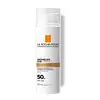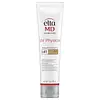What's inside
What's inside
 Key Ingredients
Key Ingredients

 Benefits
Benefits

 Concerns
Concerns

 Ingredients Side-by-side
Ingredients Side-by-side

Water
Skin ConditioningC12-15 Alkyl Benzoate
AntimicrobialGlycerin
HumectantOctocrylene
UV AbsorberNiacinamide
SmoothingButyl Methoxydibenzoylmethane
UV AbsorberDimethicone
EmollientEthylhexyl Triazone
UV AbsorberSilica
AbrasiveAluminum Starch Octenylsuccinate
AbsorbentVinyl Dimethicone/Methicone Silsesquioxane Crosspolymer
Terephthalylidene Dicamphor Sulfonic Acid
UV AbsorberPotassium Cetyl Phosphate
EmulsifyingDrometrizole Trisiloxane
UV AbsorberPEG-100 Stearate
Stearyl Alcohol
EmollientGlyceryl Stearate
EmollientAmmonium Polyacryloyldimethyl Taurate
Emulsion StabilisingBenzyl Alcohol
PerfumingBenzyl Benzoate
AntimicrobialCapryloyl Salicylic Acid
ExfoliatingCaprylyl Glycol
EmollientHydrolyzed Hyaluronic Acid
HumectantPhenoxyethanol
PreservativePhenylethyl Resorcinol
AntioxidantPoloxamer 338
EmulsifyingTocopherol
AntioxidantTriethanolamine
BufferingTrisodium Ethylenediamine Disuccinate
Xanthan Gum
EmulsifyingParfum
MaskingWater, C12-15 Alkyl Benzoate, Glycerin, Octocrylene, Niacinamide, Butyl Methoxydibenzoylmethane, Dimethicone, Ethylhexyl Triazone, Silica, Aluminum Starch Octenylsuccinate, Vinyl Dimethicone/Methicone Silsesquioxane Crosspolymer, Terephthalylidene Dicamphor Sulfonic Acid, Potassium Cetyl Phosphate, Drometrizole Trisiloxane, PEG-100 Stearate, Stearyl Alcohol, Glyceryl Stearate, Ammonium Polyacryloyldimethyl Taurate, Benzyl Alcohol, Benzyl Benzoate, Capryloyl Salicylic Acid, Caprylyl Glycol, Hydrolyzed Hyaluronic Acid, Phenoxyethanol, Phenylethyl Resorcinol, Poloxamer 338, Tocopherol, Triethanolamine, Trisodium Ethylenediamine Disuccinate, Xanthan Gum, Parfum
Zinc Oxide 9%
Cosmetic ColorantTitanium Dioxide 7%
Cosmetic ColorantWater
Skin ConditioningIsopropyl Palmitate
EmollientEthylhexyl Stearate
EmollientOctyldodecyl Neopentanoate
EmollientAlumina
AbrasivePolyacrylate-13
Phenoxyethanol
PreservativeHydrogen Dimethicone
Polyisobutene
Hydrogenated Polyisobutene
EmollientTriethoxycaprylylsilane
Oleth-3 Phosphate
Tocopheryl Acetate
AntioxidantBisabolol
MaskingTocopherol
AntioxidantCarnosine
Skin ConditioningEthylhexylglycerin
Skin ConditioningSorbitan Isostearate
EmulsifyingPolysorbate 20
EmulsifyingZingiber Officinale Root Extract
MaskingIron Oxides
Zinc Oxide 9%, Titanium Dioxide 7%, Water, Isopropyl Palmitate, Ethylhexyl Stearate, Octyldodecyl Neopentanoate, Alumina, Polyacrylate-13, Phenoxyethanol, Hydrogen Dimethicone, Polyisobutene, Hydrogenated Polyisobutene, Triethoxycaprylylsilane, Oleth-3 Phosphate, Tocopheryl Acetate, Bisabolol, Tocopherol, Carnosine, Ethylhexylglycerin, Sorbitan Isostearate, Polysorbate 20, Zingiber Officinale Root Extract, Iron Oxides
Ingredients Explained
These ingredients are found in both products.
Ingredients higher up in an ingredient list are typically present in a larger amount.
Phenoxyethanol is a preservative that has germicide, antimicrobial, and aromatic properties. Studies show that phenoxyethanol can prevent microbial growth. By itself, it has a scent that is similar to that of a rose.
It's often used in formulations along with Caprylyl Glycol to preserve the shelf life of products.
Tocopherol (also known as Vitamin E) is a common antioxidant used to help protect the skin from free-radicals and strengthen the skin barrier. It's also fat soluble - this means our skin is great at absorbing it.
Vitamin E also helps keep your natural skin lipids healthy. Your lipid skin barrier naturally consists of lipids, ceramides, and fatty acids. Vitamin E offers extra protection for your skin’s lipid barrier, keeping your skin healthy and nourished.
Another benefit is a bit of UV protection. Vitamin E helps reduce the damage caused by UVB rays. (It should not replace your sunscreen). Combining it with Vitamin C can decrease sunburned cells and hyperpigmentation after UV exposure.
You might have noticed Vitamin E + C often paired together. This is because it is great at stabilizing Vitamin C. Using the two together helps increase the effectiveness of both ingredients.
There are often claims that Vitamin E can reduce/prevent scarring, but these claims haven't been confirmed by scientific research.
Learn more about TocopherolWater. It's the most common cosmetic ingredient of all. You'll usually see it at the top of ingredient lists, meaning that it makes up the largest part of the product.
So why is it so popular? Water most often acts as a solvent - this means that it helps dissolve other ingredients into the formulation.
You'll also recognize water as that liquid we all need to stay alive. If you see this, drink a glass of water. Stay hydrated!
Learn more about Water